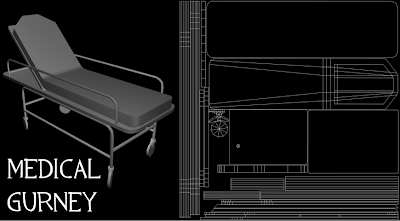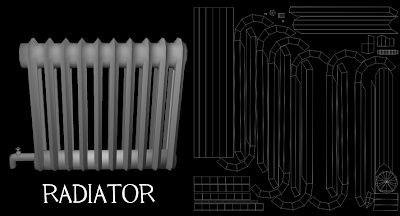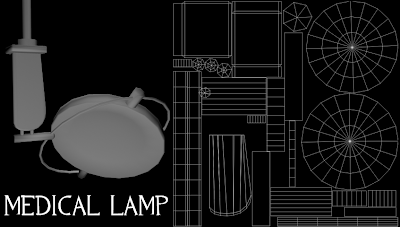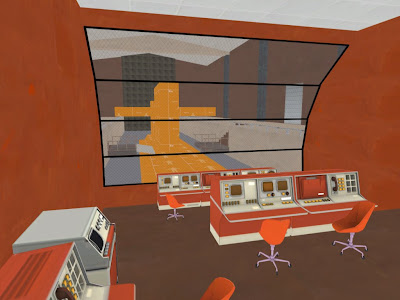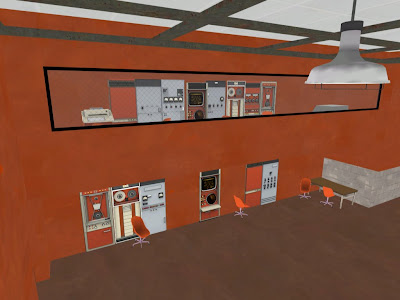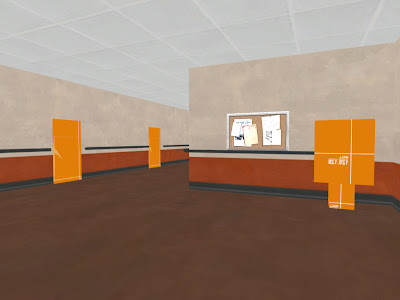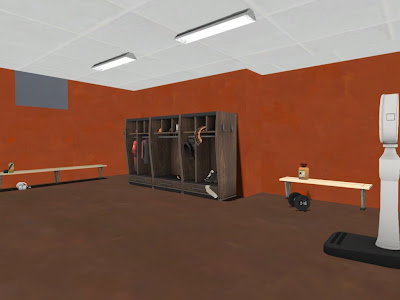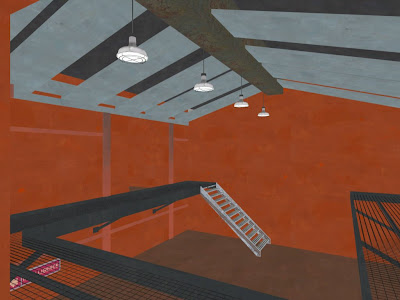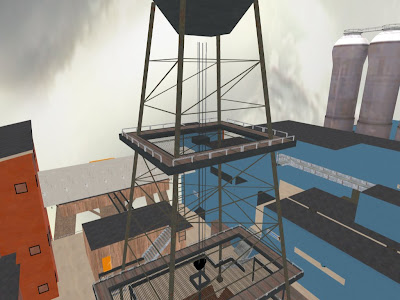
At long last, my Team Fortress 2 capture the flag map is complete! It's been a long time coming, 10 months to be exact. You may be a bit confused when you see the final product. Let me explain.
(If you just want to see the actual completed work, and not listen to my rant, skip ahead to the pics, design theory, and video).This project has definitely had its road bumps. I started out highly optimistic (too much, really) that I could complete a tf2 ctf map with completely original content. I had no prior experience with the hammer level editor, which provided even more of a road block. I eventually accepted the fact that not all of my content would be original, that some Valve props would be put into the mix. Awhile after that, I decided to change the entire interior, which cut out at least a month's time. Even further down the road, I realized that I couldn't do the project on my own. So I enlisted some help, and with some hard work and long nights, i realized it was finally tangible to get the thing done by the time I move to Chicago, which is now February or March of next year. But then I took a step back and realized two very important things that would stop me from fully finishing the map:
1) I originally wanted to put this into my demo reel. Since 75% of the content would be Valve's, I would have to specify which is theirs and which is mine. This would both be ridiculously difficult to do, and would also look bad. If I were an employer looking at such a reel, I would most likely toss it, and move onto the next one.
2) Sure, I could get it done, but would it be the best thing to do over the next year in preparation for Chicago? Nope. I seemed to forget an important lesson learned from one of my teachers. Quality over quantity, always. I could have nothing to show but this finished project, but it would be smarter to work on smaller, more focused projects of higher quality. Make more varied, better made projects, rather than one watered down one.
It was probably the hardest thing I've had to do as an artist thus far, but it was the smart way to go, so I pulled the plug. I took a week off to recharge my batteries, and when I came back and looked at it, I got an idea. I realized that I could salvage the project as a level design study. I could make the level playable, but with no finished art that would make it look like an official valve map like I originally planned. It would be more like a fully functional prototype.
Overall, I don't really have many regrets on this project. I guess the only regret I have is that I wish I could have realized then what I realize now. It would have been nice to start on another project a couple months back, but maybe I wouldn't have learned as much. I've gained a pretty good understanding of how Hammer works, and I now know how to make my own levels with original content, which is something I can be proud of. But enough talk. Here's the meat and potatoes of this post, the actual work:
For those who would like to see it in motion, the video is here:http://www.youtube.com/watch?v=zlARkKMcMqY
And for those other source engine savys, the BSP is here:
http://forums.tf2maps.net/downloads.php?do=file&id=1626
The Basic Rules: It's just like any other ctf map, except there are two locations for the intelligence. The first one spawns a little outside the base, and when that one is captured, the next one spawns further inside the base. Capture it twice, and you win(Three caps total, one outside, two inside).
General Design: The problem with most ctf maps made for Team Fortress 2 is that they basically turn into fragfests due to the intel being so hard to capture, with most players giving up on actually getting it. 2Fort for example, has the intel too far into the base. Even if you manage to get it, good luck on getting back out of the base. As a result, games tend to take forever. Ctf Turbine is a much smaller map, and games tend to go faster due to the size. Still, I tend to have a problem with this map, as it's a bit too simplistic. So, this map can be looked at as a hybrid of the two. 2Fort's multiple paths and complexity, mixed with Turbine's size. A match made in heaven. Ctf Platform appears to be large when really it isn't. It just seems that way due to the many paths you can take, and that's what makes a good ctf map. The main thing, I think, is to make the intel generally easier to capture, so that games don't take forever. I do this in a couple of ways:
-
Making places that are good to put sentries in, but making the areas avoidable, so that sentries don't hold so much power, a balance issue with ctf. If a sentry can block numerous paths at once, you can bet that a demoman can take it out very easily.
-
Putting the intelligence room near the entrance to the base. This makes it easier to get out once you've gotten it.
-
Making many paths to the intel. This makes it harder to defend, since you have to watch multiple entrances. The first capture point or "stage 1" as I call it, has 5 total ways to get to it, with 2 being reachable only with certain classes. This makes for a fast paced beginning, and really tests a team defense. Stage 2's intel has three different entry points, with one accessed only by certain classes.
-
Large intel room. Open areas are harder to defend, especially with sentries. This is why the intel area is the biggest room in the base.
Breakdown of specific areas:Neutral middle ground:

This area has a giant oil derrick plopped in the middle of it. It provides a large open area to move around for scouts, while giving enough cover so that snipers don't dominate everyone. The two buildings on the sides provide a nice little path for spies to use. The top level of the derrick is similar to 2Fort in that it allows soldiers and scouts a path to use to get the drop on the other team's first intel area. Additional tunnels are on the side that provide good flanking routes for pyros and spies. There is also a secret spot in the middle that demomen can reach. Where could that be, I wonder?
Exterior base area:


This is where the first intel is housed by a small building. The intel is very easy to reach, as mentioned earlier, and defense is critical. Walkways dot the area that take snipers to good viewpoints, on top of providing good connectivity between defense spots. Attackers can use these to get the drop, or defenders can use them to get the high ground. Two tunnels come from the sides that provide good flanking points.
Interior Base Area:



There are two entrances on the left and right sides that merge the paths together again near the intel room. More walkways are present to once again place an emphasis on height advantage for either team. This leads into the large intel room that is open enough to provide at least somewhat of an advantage for the attackers. It is an uphill climb to get the intel, but an L-shaped walkway provides some high ground for the attackers as well. An underground path is accessable under the right side entrance to the base, that provides even more ground for the defenders to cover. It serves as a good route for spies and pyros, and also provides a good sentry spot, probably the best in the level. There is also an air vent that scouts and soldiers can use that takes them straight to the intel, which adds a layer of interesting complexity to defending as well.
Spawn rooms:

They are made with two exit paths (one shown above), so that the defenders can get to the base entrance quickly, and to the intel room sort of quickly. This makes it so that it doesn't take forever to get to the other base, while also providing a fairly quick path to defend the intel, but not too quick, so that attackers stand more of a chance.
What's Next?: I've been in talks with some people on making a left 4 dead map next. It will be a survival mode map, mainly because they are small by nature, and it will be a lot more tangible to make a completely custom map in a decent amount of time. I will also be working on some smaller self projects along the way. More on that as they come into being.
As for now, I'm gonna lay back, relax, play some games, watch some movies. It feels good to be done at last. :)
 Seriously though, it's like comparing the PS2 to the PS3. No comparison. Richer colors, better composition, better details, better materials, everything. It's mainly thanks to Unreal's new SDK (software development kit) that they released. After the gun was done, I did some relearning on my unreal editor skills, when I stumbled upon some information that said that Epic Games released their full version of the development tools they used to create Gears of War and Unreal Tournament. Naturally, I replaced my crappy version with it, and viola! More creative options! The big one is their new lighting system, called lightmass. It simulates how the lights in your scene interact with surfaces. It simulates how light bounces around, and bleeds colors onto each other, etc. All kinds of stuff that makes it look more realistically lit. Also, I redid the texturing on the ground, moving objects closer together, and completely revamped the medical lamp. Then, I added in some high contrast in Photoshop, which accurately represents how it will look when I run a contrast filter for the video.
Seriously though, it's like comparing the PS2 to the PS3. No comparison. Richer colors, better composition, better details, better materials, everything. It's mainly thanks to Unreal's new SDK (software development kit) that they released. After the gun was done, I did some relearning on my unreal editor skills, when I stumbled upon some information that said that Epic Games released their full version of the development tools they used to create Gears of War and Unreal Tournament. Naturally, I replaced my crappy version with it, and viola! More creative options! The big one is their new lighting system, called lightmass. It simulates how the lights in your scene interact with surfaces. It simulates how light bounces around, and bleeds colors onto each other, etc. All kinds of stuff that makes it look more realistically lit. Also, I redid the texturing on the ground, moving objects closer together, and completely revamped the medical lamp. Then, I added in some high contrast in Photoshop, which accurately represents how it will look when I run a contrast filter for the video.
























